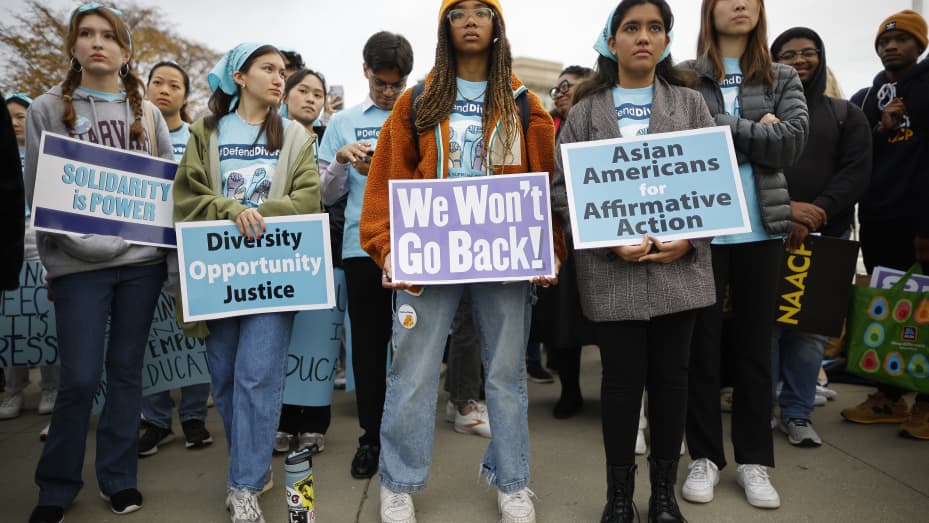Asian-American students denied seats at Harvard Due to Poor “Likeability” Rating; University of North Carolina Unwilling to Consider Race-neutral Alternatives.
On Oct. 31, the chief justices of the Supreme Court heard arguments brought by Students For Fair Admissions (SFFA), that revealed admission practices at Havard and the University of North Carolina are concerning.
SFFA claims that Asian-American students are systematically and consistently discriminated against in Havard admissions based on their race.
Asian-Americans are “substantially stronger” in nearly every measurable metric of admissions: SAT and GPA scores, extracurricular activities, and personal interviews. However, it is in the subjective area of “personal rating” of integrity, courage, kindness and empathy that they are given the worst possible scores, dampening their chances of admission.
SFFA argues that ‘Harvard is obsessed with race. Havard awards preferences to applicants who check the box for “Black” or “Hispanic”….And Havard never verifies whether applicants are really the race they check.”
In other areas of diversity such as religion, socio-economic and geographic diversity, Havard “blinds itself.” SFFA concludes that this is their way of getting the right percentages of racial groups in a racial balancing act, and not to “examine the file of a particular minority applicant…for his potential contribution to diversity.”
The 2003 ruling in the case Grutter v. Bollinger set a precedent that race can be used as a factor when considering admissions for students to institutions of higher learning. The Equal Protection Clause within the ruling allowed for race to be considered within strict parameters. A university’s admission program had to be narrowly tailored toward the goal of educational benefits achieved by having a diverse student body.
The SFFA case is interesting because it forces the meaning of diversity into the spotlight. Is diversity only in the color of the skin? SFFA noted that Grutter states it is the “experience of being a racial minority in a society, like ours, in which race unfortunately matters,” yet Havard routinely gave preference to African Americans regardless of their backgrounds.
Harvard’s own Randall Kennedy said “Let’s be honest. Many who defend affirmative action for the sake of diversity are actually motivated by…social justice.”
The director of the Race and Intersectional Studies for Educational Equity (RISE) Center at Colorado State University, Oiyan Poon, recently commented that for Asian-Americans “It’s interpersonal … They’re not necessarily understanding it as a systemic problem that requires systemic solutions. And affirmative action is a systemic solution.” RISE is an entity that operates “Using an intersectional lens, the Center understands racism as a system that is intertwined with other structures of oppression (e.g., sexism, classism, homophobia, transphobia, etc.) that functions to (re)produce social injustices.”
The Gutter ruling was not made in the name of social justice or even for a diverse student body particularly, but primarily for the educational benefits realized through diversity.
The ruling came with a sunset of twenty-five years, warning that the Supreme Court expects that “racial preferences would no longer be necessary.” In other words, twenty-five years is sufficient time to see whether there are any evident benefits in admissions, between universities that use race-based admissions and those that do not.
This is where SFFA challenges both Havard and the University of North Carolina. States such as California, where admissions are not race-based, have seen diverse undergraduate admissions explode to record numbers. Last July the UC system admitted the largest most diverse undergraduate class in its history, begging the question of the necessity of emphasizing race as a factor in admissions and demonstrating that workable race-neutral alternatives exist to achieve the same goal. Even in historically black universities where diversity is much less, a rich education is realized through diversity of ideas, experiences and backgrounds. Arizona, Washington, and other race-neutral states have found success in admitting diverse students and providing a rich education as well.
The University of North Carolina has refused to consider race-neutral alternatives despite models showing minimal change to admissions.
Admission programs based on the Gutter ruling, sanctions discrimination based on race, giving higher admission points to individuals of a particular race and lower points to others, but while it may all sound like “process,” the repercussions on real lives and real students are not benign. One high school counselor wept openly in her deposition when shown the admission statistics for Asian Americans, lamenting the reality that for some, these were just numbers, but for her they were faces of children who were really hard-working students that she loved.
“As a first-generation Korean American who came to this country when I was 19 years old, I believe every student should be able to build their own American Dream,” said Rep Michelle Steel (CA). “If these admissions tactics are truly being used at institutions of higher education, applicants deserve to know.”
Steel is promoting transparency at institutions of higher learning through the Helping Applicants Receive Valid and Reasonable Decisions (HARVARD) Act, which requires colleges to disclose if a personality trait metric factors in their admission decisions.
The Pew Research Center in Apr. 2022 found that 74% of all Americans do not believe that race should be considered in college admissions. This view was supported by 59% African-Americans and 68% Hispanics.
“Earlier this year U.S. Sen. Ted Cruz, R-Texas, and I submitted an amicus brief urging the Supreme Court to take this opportunity to correct this decades-old injustice and end the use of race in admissions processes. Eighty of our congressional colleagues joined us in support of students nationwide. We believe that discrimination is against the fundamental values of American culture, and that includes discrimination against the Asian American Pacific Islander community in the halls of our schools and universities,” Steel said.


